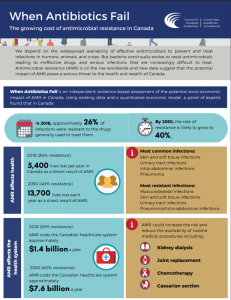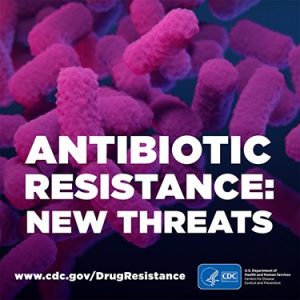I’ll leave the summary of two antimicrobial resistance reports to my friend and hockey colleague (and he’s a professor/veterinarian) Scott Weese of the Worms & Germs Blog (he’s the semi-bald dude behind me in this 15-year-old pic; I’m the goalie; too many pucks to the head):
 Two reports came out this week, both detailing the scourge of antibiotic resistance.
Two reports came out this week, both detailing the scourge of antibiotic resistance.
In Canada, the Canadian Council of Academies released “When antibiotics fail: the expert panel on the potential socio-economic impacts of antimicrobial resistance in Canada.”
Not to be outdone, the CDC released Antibiotic Resistance Threats in the United States, 2019.
They’re both comprehensive, with a combined >400 pages explaining that this is a big problem.
I’m not going try to summarize the reports. I’ll just pick out a few interesting tidbits.
From the CCA report (Canada):
According to their modelling, first-line antimicrobials (those most commonly used to treat routine infections) helped save at least 17,000 lives in 2018 while generating $6.1 billion in economic activity in Canada. “This contribution is at risk because the number of effective antimicrobials are running out.”
Antimicrobial resistance was estimated to reduce Canada’s GDP by $2 billion in 2018. That’s only going to get worse unless we get our act together. It’s estimated that by 2050, if resistance rates remain unchanged, the impact will be $13 billion per year. If rates continue to increase, that stretches to $21 billion. Remember, that’s just for Canada, a relatively small country from a population standpoint.
 Healthcare costs due to resistance (e.g. drugs, increased length of stay in hospital) accounted for $1.4 billion in 2018. But remember that people who die from resistant infections can actually cost less. If I get a serious resistant infection and die quickly, my healthcare costs are pretty low since I didn’t get prolonged care. All that to say that dollar costs alone don’t capture all the human aspects. Regardless, this cost will likely increase to $20-40 billion per year by 2050.
Healthcare costs due to resistance (e.g. drugs, increased length of stay in hospital) accounted for $1.4 billion in 2018. But remember that people who die from resistant infections can actually cost less. If I get a serious resistant infection and die quickly, my healthcare costs are pretty low since I didn’t get prolonged care. All that to say that dollar costs alone don’t capture all the human aspects. Regardless, this cost will likely increase to $20-40 billion per year by 2050.
In terms of human health, resistant infections were estimated to contribute to 14,000 deaths in Canada in 2018, with 5,400 of those directly attributable to the resistant infection (i.e. those deaths would not have occurred if the bug was susceptible to first line drugs). That makes resistance a leading killer, and it’s only going to get worse.
I’ll stop there. The document has a lot of good information and it’s worth reading if you’re interested in the topic. They also provided a handy 2-page “infographic” summary if you can’t quite stomach the complete 268-page report (also see image below).
The document’s dedication says a lot. “This report is dedicated to the 48,700 families who lose a loved one each year to antibiotic resistance or Clostridioides difficile, and the countless healthcare providers, public health experts, innovators, and others who are fighting back with everything they have.”
The forward has some great messages too:
To stop antibiotic resistance, our nation must:
 Stop referring to a coming post-antibiotic era—it’s already here. You and I are living in a time when some miracle drugs no longer perform miracles and families are being ripped apart by a microscopic enemy. The time for action is now and we can be part of the solution.
Stop referring to a coming post-antibiotic era—it’s already here. You and I are living in a time when some miracle drugs no longer perform miracles and families are being ripped apart by a microscopic enemy. The time for action is now and we can be part of the solution.
Stop playing the blame game. Each person, industry, and country can affect the development of antibiotic resistance. We each have a role to play and should be held accountable to make meaningful progress against this threat.
Stop relying only on new antibiotics that are slow getting to market and that, sadly, these germs will one day render ineffective. We need to adopt aggressive strategies that keep the germs away and infections from occurring in the first place.
Stop believing that antibiotic resistance is a problem “over there” in someone else’s hospital, state, or country—and not in our own backyard. Antibiotic resistance has been found in every U.S. state and in every country across the globe. There is no safe place from antibiotic resistance, but everyone can take action against it. Take action where you can, from handwashing to improving antibiotic use.
Some might say it’s alarmist. However, I don’t think it’s alarmist when someone really should be raising the alarm. We need to talk about it more, not less. We need to get people (including the general public, healthcare workers, farmers, veterinarians, policymakers) on board, to realize it’s a big issue that needs to be addressed now. “Short term pain for long-term gain” certainly applies here. We can keep delaying and the numbers will keep going up, or we can invest in solutions.
The numbers are scary but specific numbers don’t really matter in many ways. “Lots” is all we should have to know to get motivated. However, decision-makers like numbers, so these numbers hopefully will be useful to show the impact and potential benefits of investing in this problem, and motivate them to put money into antimicrobial stewardship. Saving lives should be enough, but that often doesn’t cut it. Antibiotic resistance doesn’t have a good marketing campaign. Everyone knows why people were wearing pink last month and why there are some pretty dodgy moustaches this month. Those are important issues, for sure. However, considering the overall impact, antibiotic stewardship needs to get more people behind it if we’re going to effect change.









 T
T


